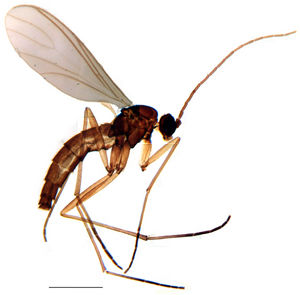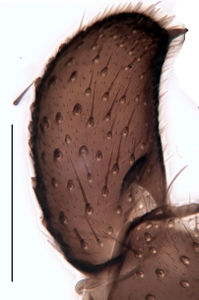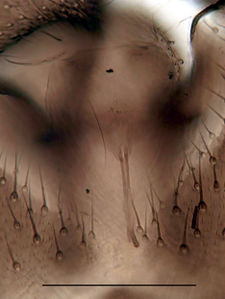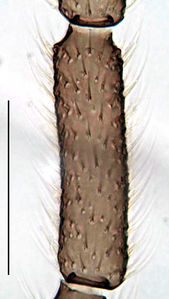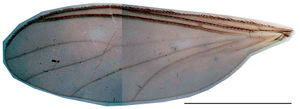Trichosiopsis dimera
Ordo: Diptera
Familia: Sciaridae
Genus: Trichosiopsis
Name
Trichosiopsis dimera Tuomikoski, 1960 – Wikispecies link – ZooBank link
- Trichosia (Leptosciarella) dimera Tuomikoski, 1960[1]: 23-24; fig. 4a, 5a, 5g
- Leptosciarella (Leptosciarella) dimera (Tuomikoski, 1960)[2]: 69-70; fig. 17
Type material
Lectotype: ♂, in MZH, leg. Tuomikoski, 18.06.1958
Type locality
Finland, Vihti, Vihtijärvi
Material studied
Czech Republic: 1 ♂, Bohemia, Šumava mountains, Malá Niva, peat bog, photoeclector, Barták, 06.-07.1997, SDEI 2453; Finland: 2 ♂, Kb, Koli, Pielisjärvi, birch/spruce/aspen forest, sweep netting, Jaschhof, 11.06.2004, PKHH 6338, MZH 9068; N, Lapinjärvi, spruce forest, photoeclector, Yakovlev, 25.4.-30.06.2005, MZH 9185; Germany: 7 ♂, Baden-Württemberg, Bad Rotenfels, Bannwald Birkenkopf, Malaise trap, Doczkal, 3.4.-03.05.2003, PKHH 5065-5066, PDDM 141, PASS 141, ZSMC 2290-2291; 1 ♂, Blaubeuren, Tiefental, gorge forest, yellow pan trap, Sipple, 15.-22.04.2009, PKHH 7054; 7 ♂, Malsch, Wald NE Kieswerk Glaser, clearing, beech stump, Malaise trap, Doczkal, 19.3.-21.04.2010, PKHH 7886; 1 ♂ 1 ♀, Mössingen, Hirschkopf, fountain Hi 3, beech forest, W of landslip, sweep netting, Gerecke, 25.04.2012, PKHH 8004; 1 ♂, Mecklenburg-Vorpommern, Klepelshagen, Buchenwald, sweep netting, Jaschhof, 23.04.1994, PKHH 5376; 3 ♂, Rosenthal near Strasburg, sweep netting, Jaschhof, PKHH 5314, 5315, 5317; 2 ♂, Rhineland-Palatine, Kirchheimbolanden, NSG Albertskreuz, Malaise trap, Doczkal, 11.4.-02.05.2002, PKHH 5092, 5098; Saxony, 1 ♂, Chemnitz, Zeisigwald, yellow pan trap, 01.-14.04.2008, Erlacher, MNC 36; 1 ♂, 15.04.-04.05.2008; Greece: 1 ♂, Procom, riverine forest along river Strymon; Populus alba, Juglans regia and Corylus avellana, Malaise trap, Ramel, 10.-16.03.2008, PKHH 7014; Sweden: 3 ♂, Bohuslän, Ödsmal, Hällsberget, broad leaved deciduous forest, Malaise trap, Swedish Malaise Trap Project, 24.4.-25.05.2004, PKHH 5837, 7282, 7283; 7 ♂, Östergötland, Omberg, Storpissan: old Norway spruce wood, Malaise trap, Swedish Malaise Trap Project, 3.3.-28.05.2005, NHRS 1838-1744; 13 ♂, Skåne, Simrishamn, Stenshuvud National Park: Svabeholmsskog, hornbeam forest, Malaise trap, Swedish Malaise Trap Project, 22.5.-20.06.2005, NHRS 2977, 2978, PKHH 7253; 10 ♂, Småland, Alsterbro, Mixed forest, Malaise trap, Swedish Malaise Trap Project, 30.4.-05.05.2005, PKHH 6684; 16 ♂, 15.-20.05.2005, PKHH 6600, 6608; 1 ♂, Bäckebo, Grytsjöns naurreservat, Old moisty haymaking meadow in forest edge, Malaise trap, Swedish Malaise Trap Project, 27.4.-18.05.2006, NHRS 3011; 1 ♂, 18.5.-15.06.2006, PKHH 6856; 1 ♂, Gränna, Lönnemålen, next to old cellar; Norway spruce forest with big harvested ashes, Malaise trap, Swedish Malaise Trap, 28.4.-19.05.2004, PKHH 7949; Switzerland: 2 ♂ 2 ♀, Zurich, Sihlwald, window trap, Schiegg, 25.4.-11.05.1996, PKHH 1560, PWMP 1562; 2 ♂, photoeclector, Schiegg, 25.4.-23.05.1996, PKHH 2458; 1 ♂, 24.5.-19.06.1996, PKHH 2423; 2 ♂, window trap, Schiegg, 12.-23.05.1996, PKHH 1534; 1 ♂, 25.4.-11.05.1996, PKHH 1543; Ukraine: 1 ♂, Sakarpatje, near Rakhiv, sweep netting, Dimitrieva, 11.04.1990, PWMP 1771.
Description (male)
Head. Eye bridge 3 rows of facets. LW-index of 4th antennal flagellar segment 3–4.5; neck 0.25–0.38 of segment width; Transition of basal part to neck pronounced. Colour of neck unicolour. Antennal hairs as long as segment width; sparse; salient. Palps darkened; short; palpomeres 2, or 3. First palpomere thickened; with 4–5 bristles; with only some sparse sensillae. Second palpomere shortly oval. Third palpomere shorter than first segment, or as long as first segment. Thorax. Colour reddish. Notum unicolorous. Thoracic setae long and strong; dark. Mesonotum with some weaker central bristles. Posterior pronotum bare. Laterotergite bare. Legs. Colour yellow. Hind coxae of same colour as femora, or darkened. Hairs on fore coxae black. Front tibia apically with a patch of setae. Front tibial organ not bordered. Tibial setae on hind legs weak, inconspicuous. Tibial spurs of equal length. Claws untoothed. Wings. Wings slightly darkened; reduced, with weakly developed anal lobe. Wing membrane without macrotrichia. Wing venation weak, with faint m-base. M-fork of normal shape. R1 inserting clearly before base of m-fork; posterior veins with macrotrichia; stM bare; cuA1 and cuA2 mainly with macrotrichia, or with a few macrotrichia; bM bare; r-m bare; bM:r-M 0.85–1.05; st-Cu:bM 0.45–0.6; r1:r 1.3–1.55; C:w 0.65–0.75. Halteres dark; of normal length. Abdomen. Abdominal setae strong and dense; dorsally dark; ventrally dark. Hypopygium concolour with abdomen; 0.55–0.7 × longer than wide. Base of gonocoxites with normal, weak hairs; gonocoxites broadly separated; inner margin of gonocoxites normally U-shaped; inner part of hypopygium scarcely setose; elongated setae on valves of hypopygium absent. Gonostylus elongate; 2–2.2 × longer than wide; Inner margin concave; apex equally rounded. Apical tooth present; 1.8–2.1 × longer than broad; normal. Awl-like setae normal; below apex present. Megasetae on inner part of gonostylus absent. Whiplash-hair absent. Tegmen 0.6–0.72 × longer than broad; rectangular with rounded edges; normal; Central process absent. Length of aedeagus/hypopygium 25–35 %; Aeadeagal apical structure present. Measurements. Body size 3–3.5 mm. Hind tibia 1.6–1.75 mm. Wing length 2.3–3 mm.
Diagnosis
Trichosiopsis dimera is characterized by the very long antennae and rounded gonostyli. The antennae are still longer than in the similar Trichosiopsis cerifera, which can otherwise be distinguished by the longer palpi and the more parallel gonostyli. The also similar species Trichosiopsis viatica has a more thickened first palpomere, shorter antennae and bright coxal hairs and halteres. The species was named “dimera” because the type specimen has two segmented palpi. Although the palpi are generally reduced in Tr. dimera most specimens observed have three-segmented palpi, only the two last segments often appear to be fused.
DNA Barcoding
The COI sequence is assigned to BIN BOLD:ACD9636 (average distance 0.79%, max. 1.85%, n=71, K2P: 12.12%).
Etymology
gr. di- = two; gr. meron = part. The name makes reference to two-segmented palpi.
Ecology
Like Tr. viatica Trichosiopsis dimera is commonly found in decaying wood. It is obviously widespread in European forests.
Distribution
Czech Republic[3][4], Finland[1][5][6], Germany[7][8][9], Great Britain[10], Greece, Latvia[2], Norway[11], Slovakia[12][13] , Sweden[14], Switzerland, Ukraine[2].
Images
|
References
- ↑ 1.0 1.1 Tuomikoski, R. 1960: Zur Kenntnis der Sciariden (Dipt.) Finnlands. Annales Zoologici Societatis Zoologicae Botanicae Fennicae “Vanamo”, 21, 1–164.
- ↑ 2.0 2.1 2.2 Mohrig, W.; Menzel, F. 1997: Revision der paläarktischen Arten von Trichosia Winnertz sensu Tuomikoski, 1960 (Diptera, Sciaridae). – Teil II. Gattungen Leptosciarella Tuomikoski, 1960 und Trichodapus gen. nov. Studia dipterologica, 4(1), 41–98.
- ↑ Menzel, F.; Mohrig, W.; Barták, J. 2000: Sciaridae. In: J. Vanhara & M. Barták (Eds.), Diptera in an industrially affected region (North-Western Bohemia, Bilina and Duchcov Environs), I, Folia Facultatis Scientiarum Naturalium Universitatis Masarykianae Brunensis (104). pp. 73-81.
- ↑ Rudzinski, H.-G. 2000: Neue Trauermücken aus Mähren (Diptera: Sciaridae). Mitteilungen des Internationalen Entomologischen Vereins e. V., 25, 75–86.
- ↑ Salmela, J.; Vilkamaa, P. 2005: Sciaridae (Diptera) from central Finland: faunistics and taxonomy. Entomologica Fennica, 16, 287–300.
- ↑ Vilkamaa, P.; Salmela, J.; Hippa, H. 2007: Black fungus-gnats in deciduous forest habitat in northern Europe, with the description of Bradysia arcula sp. n. (Diptera: Sciaridae). Entomologica Fennica, 18(4), 226-231.
- ↑ Rudzinski, H.-G. 1995: Neue Nachweise von Trauermücken in Bayern (Diptera Nematocera, Sciaridae). Entomofauna, 16, 277–279. PDF
- ↑ Hövemeyer, K. 1998: Diptera associated with dead beech wood. Studia dipterologica, 5(1), 113–122.
- ↑ Heller, K.; Erlacher, S.I. 2012: Zehn für Sachsen neue Trauermücken aus dem Chemnitzer Zeisigwald (Diptera: Sciaridae). Veröffentlichungen des Museums für Naturkunde Chemnitz, 35, 85–90.
- ↑ Menzel, F.; Smith, J.E.; Chandler, P. 2006: The sciarid fauna of the British Isles (Diptera: Sciaridae), including descriptions of six new species. Zoological Journal of the Linnean Society, 146, 1-147. PDF
- ↑ GBIF Trichosiopsis dimera
- ↑ Rudzinski, H.-G. 2009: Die Trauermücken des Poľana Biosphären-Reservats (Diptera: Sciaridae). Casopis Slezskeho zemskeho muzea, serie A, 58, 39-46.
- ↑ Rudzinski, H.-G.; Ševčík, J. 2012: Fungus gnats (Diptera: Sciaroidea) of the Gemer region (Central Slovakia): Part 3 – Sciaridae. Časopis Slezského zemského muzea, 61, 143–157.
- ↑ Heller, K.; Vilkamaa, P.; Hippa, H. 2009: An annotated check list of Swedish black fungus gnats (Diptera, Sciaridae). Sahlbergia, 15(1), 23-51.
